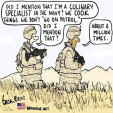Našim revírem jsou bitevní pole, naše tempo je sebevražedné, naši protivníci jsou předem poraženi. Muži a ženy z klanu N-CZ se chtějí bavit ve dne i v noci a jejich úkolem je chránit svou bezpečnost!
...
Sdílíme společnou vášeň pro motorky! (a akvárka)

Naposledy editováno 05.12.2013 13:19:18
1 reakcí na tento příspěvek (reakce na) World of Tanks
/edit
nerad bych se mejlil, ale APCR podle me neni podkaliberni...
Armour-piercing, composite rigid
Armour-piercing, composite rigid (APCR) is a British term, the US term for the design is high velocity armor piercing (HVAP) and German, Hartkernmunition. The APCR projectile is a core of a high-density hard material such as tungsten carbide surrounded by a full-bore shell of a lighter material (e.g., an aluminium alloy). Most APCR projectiles are shaped like the standard APCBC shot (although some of the German Pzgr. 40 and some Soviet designs resemble a stubby arrow), but the projectile is lighter: up to half the weight of a standard AP shot of the same calibre. The lighter weight allows a higher velocity. The kinetic energy of the shot is concentrated in the core and hence on a smaller impact area, improving the penetration of the target armour. To prevent shattering on impact, a shock-buffering cap is placed between the core and the outer ballistic shell as with APC rounds. However, because the shot is lighter but still the same overall size it has poorer ballistic qualities, and loses velocity and accuracy at longer ranges. The APCR was superseded by the APDS which dispensed with the outer light alloy shell once the shot had left the barrel. The Germans used an APCR round, the Panzergranate 40 (Pzgr.40) "arrowhead" shot, for their 5 cm Pak 38 antitank guns in 1942, and it was also developed for their 75 and 88 mm antitank and tank guns, and for anti-tank guns mounted in German aircraft. Shortages of the key component, tungsten, led to the Germans dropping the use of APCR during late World War II because tungsten was more efficiently used in industrial applications such as machine tools. The concept of a heavy, small-diameter penetrator encased in light metal would be later employed in small-arms armor-piercing incendiary and HEIAP rounds.
Naposledy editováno 15.09.2013 18:45:27






